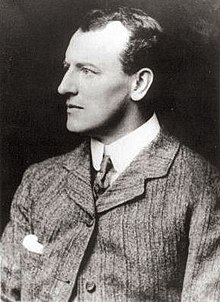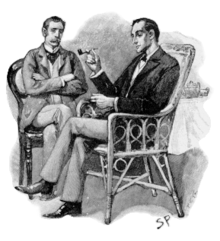Sidney Paget
Sidney Paget | |
|---|---|
 Paget inc. 1890 | |
| Born | Sidney Edward Paget 4 October 1860 Clerkenwell,London, England |
| Died | 28 January 1908(aged 47) |
| Notable work | The Strand Magazineillustrations |
| Spouse |
Edith Hounsfield (m.1893) |
| Children | 6 |
Sidney Edward Paget(/ˈpædʒɪt/;[1]4 October 1860 – 28 January 1908) was a British artist of theVictorian era,best known for his illustrations that accompaniedArthur Conan Doyle'sSherlock Holmesstories inThe Strand Magazine.
Life
[edit]Sidney Paget was the fifth of nine children born to Robert Paget, the vestry clerk ofSt. Jamesand St. John inClerkenwell,and Martha Paget (née Clarke), a music professor. In 1881 Paget entered theRoyal AcademySchools. Here he befriended Alfred Morris Butler, an architecture student who may have become the model for Paget's illustrations ofDr. John Watson.Between 1879 and 1905 Paget contributed eighteen paintings, including nine portraits, to the Royal Academy exhibitions.
Paget's drawings appeared in theStrand Magazine,thePictorial World,The Sphere,The Graphic,The Illustrated London News,andThe Pall Mall Magazine,and his work became well known in both the United Kingdom and United States. He provided illustrations forArthur Morrison's Martin Hewitt detective stories andArthur Conan Doyle'sSherlock Holmeswork, doing much to popularise both series.
On 1 June 1893, Sidney Paget married Edith Hounsfield (1865—1942 or 1932?), daughter of William Hounsfield, a farmer.[2]They had four daughters and two sons together: Leslie Robert (1894—1942); Winifred (1896); Edith Muriel (1897); Evelyn Mereoah (1899); Beryl May (1902—1955) and John L. Paget.
Sidney Paget died inMargateon 28 January 1908, at age 47, after suffering from a painful chest complaint for the last few years of his life. According to his death certificate, the cause of death was "Mediastinal tumour,3 years, exhaustion ". Mediastinal tumours are growths that form in the central chest; as they grow, they increasingly constrict the lungs. The condition is rare, with unknown causes, and in the early twentieth century led to a painful and certain death.
Paget was buried inEast Finchley Cemetery.Two brothers,H.M. (Henry Marriott) Paget(1856–1936) andWal (Walter Stanley) Paget(1863–1935) were also successful portraitists and illustrators.[2]
The Strandillustrations
[edit]


Paget is best remembered as the creator of the popular image ofSherlock Holmesfrom the original publication of Conan Doyle's stories inThe Strand Magazine.He was originally hired to illustrateThe Adventures of Sherlock Holmes,a series of twelve short stories that ran from July 1891 through June 1892.
In 1893, Paget illustratedThe Memoirs of Sherlock Holmes,published inThe Strandas further episodes of theAdventures.When Sir Arthur Conan Doyle revived the Sherlock Holmes series withThe Hound of the Baskervilles,serialised inThe Strandin 1901–02, he specifically requested that Paget be the illustrator. Paget went on to illustrate another short story series,The Return of Sherlock Holmes,in 1903–04. In all, he illustrated one Holmes novel and 37 Holmes short stories. His illustrations have influenced interpretations of the detective in fiction, film and drama.
The Strandbecame one of Great Britain's most famous fiction magazines, with the Holmes series its most popular feature. As Holmes' popularity grew, Paget's illustrations became larger and more elaborate. Beginning with "The Adventure of the Final Problem"in 1893, almost every Holmes story inThe Strandfeatured a full-page illustration as well as many smaller ones.
Paget was the first to give Holmes hisdeerstalkercap andInverness cape– details never mentioned in the stories and novels.[3]The cap and cape first appear in an illustration for "The Boscombe Valley Mystery"in 1891 and reappear in"The Adventure of Silver Blaze"in 1893; they also appear in a few illustrations fromThe Return of Sherlock Holmes.(The curvedcalabash pipewas added by the stage actorWilliam Gillette.)
Altogether, Paget did some 356 published drawings for the Sherlock Holmes series. His depictions of Holmes became iconic and other illustrators found themselves compelled to imitate his style in their own depictions of Holmes.
A complete set ofThe Strandissues featuring the illustrated Sherlock Holmes tales is one of the rarest and most expensive collector's items in publishing history. Paget's original 6.75 x 10.5-inch drawing of "Holmes andMoriartyin Mortal Combat at the Edge of theReichenbach Falls"was sold bySotheby'sin New York on 16 November 2004 for $220,800.
Legend holds that the publishers ofThe Strandhired Paget accidentally when he mistakenly responded to a letter of commission intended for his younger brother Walter,[2]but a 2019 paper published in theBaker Street Journalfound no evidence for this story and much against it.[4] Another commonly held belief – that Paget modeled his depiction of Holmes on that of Walter – was denied by their brother Henry Marriott Paget.[5]
Notes and references
[edit]- ^Jones, Daniel;Gimson, Alfred C.(1977) [1917].Everyman's English Pronunciation Dictionary.Everyman's Reference Library (14 ed.). London: J. M. Dent & Sons.ISBN0-460-03029-9.
- ^abcCooke, Catherine (2007)."Portraits by the friend of Sherlock Holmes discovered in the City of Westminster"(PDF).City of Westminster.
- ^Tallon, Philip; Baggett, David, eds. (12 September 2012).The Philosophy of Sherlock Holmes.University Press of Kentucky.pp. 99–100.ISBN978-0-8131-3671-4.
- ^Matetsky, Ira Brad (Summer 2019). "Another Sherlockian Myth Debunked: Time to Turn the Page(t)?".The Baker Street Journal.69(2): 6–10.
- ^Oxford Dictionary of National Biography,1912
External links
[edit]- Works by Sidney PagetatProject Gutenberg
- Works by or about Sidney Pagetat theInternet Archive
- Sidney PagetatLibrary of Congress,with 10 library catalogue records
